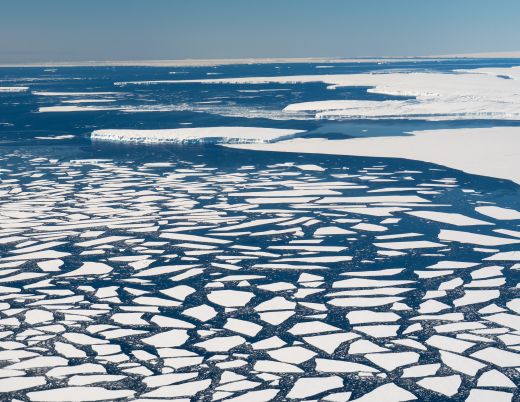
The melting of the Antarctic Ice Sheet could contribute half a metre of sea-level rise in the coming century, a significant increase to estimates from just five years ago, a new study has found.
The found that Antarctic Ice Sheet change is particularly driven by the interaction between ice shelves and ocean conditions.
Lead author and IMAS lecturer Dr Taryn Noble worked with a team of national and international experts on the wide-ranging assessment of Antarctic variability in the past, present and near future.
“We looked at the current understanding of interactions between the ice sheet, climate and the ocean, and at the underlying Earth structure that can either amplify or dampen responses of the ice sheet to climate change,” Dr Noble said.
“This highlighted the gaps in our understanding, and provides a crucial foundation for targeting new research in this challenging environment, to effectively and efficiently address these knowledge gaps.”
Dr Noble said the assessment revealed substantial changes in atmospheric and oceanic circulation patterns around the ice sheet that are associated with global climate change.
“These changes noticeably affect the Antarctic Ice Sheet and result in sea-level rise,” Dr Noble said.
“We also highlight that the fastest rates of change occur in portions of the ice sheet that cover large basins extending below sea level.
“These regions experience the greatest change because they are the most directly affected by the warming ocean, a condition that exists in both West and East Antarctica,” she said.
“Our assessment also found that the ice sheet changes over a range of timescales, from decades to centuries and millennia.
“Using data and modelling for past warm periods, the assessment suggests that Antarctic ice melt alone will plausibly contribute around half a metre of sea-level rise per century, in response to ongoing global warming.
“Meanwhile, the input of meltwater to the surrounding Southern Ocean has implications for the global climate, through changes in sea ice cover and ocean circulation, and this can amplify the melting of Antarctic ice shelves,” Dr Noble said.
Co-author Professor Eelco Rohling, from the Australian ³Ô¹ÏÍøÕ¾ University, stressed the importance of the compiled information for improving the accuracy of projections of Antarctic variability and its role in global climate change.
“To validate the models used for such projections, we require a deep understanding of all the different drivers of ice sheet change,” Professor Rohling said.
“This includes time series data of past changes in the ice and surrounding environments.
“Field studies in and around Antarctica are challenged by hostile conditions, but it is only through a combination of modelling and data-based reconstructions that progress can be made,” he said.
The assessment looked at the problem from all relevant angles, through all the major scientific disciplines needed. This included satellite observations, observations from the atmosphere, ocean, sea ice and land ice, computer modelling, studies of past variations based on cores from the ice and sea floor, detailed sea-floor maps, and geophysical observations and modelling of the Earth structure underneath the ice sheet.
“Our assessment has highlighted the priority research areas needed to address the gaps in our current knowledge, and to understand the consequences of global sea‐level rise from melting of the Antarctic Ice Sheet,” Dr Noble said.
The review was supported by the Australian Research Council (ARC) , the University of Tasmania and the , and contributes to targeting new research to address knowledge gaps in the
Image credit: Lenneke Jong, AAD.







